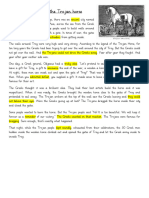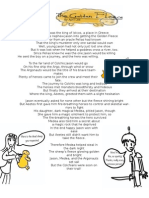Troya Final
Troya Final
Uploaded by
ALEJANDRO ZABALACopyright:
Available Formats
Troya Final
Troya Final
Uploaded by
ALEJANDRO ZABALACopyright
Available Formats
Share this document
Did you find this document useful?
Is this content inappropriate?
Copyright:
Available Formats
Troya Final
Troya Final
Uploaded by
ALEJANDRO ZABALACopyright:
Available Formats
IN SUMMARY
Legend has it that on April 24, 1124 B.C. After ten long years of siege, the
Greeks entered the impregnable city using an enormous wooden horse that
the Trojans, in their innocence, introduced into the city. The first stories
that refer to this event, mythical or historical, are found in literature,
specifically in Homer's Odyssey: "It sings about the wooden horse that
Epeo built together with Athena and that the divine Odysseus took to the
acropolis to way of deceit, filling it with the men who destroyed Troy.
WHY THE TROY WAR?
After the abduction of the beautiful Helen, wife of Menelaus, king of Sparta
and brother of Agamemnon of Mycenae, the Spartans formed a league with
other Greek cities to attack Troy and rescue their queen.
THE IDEATION OF THE TROY HORSE
The soothsayer Calchas observed a dove pursued by a hawk. The dove
took refuge in a crevice and the hawk remained near the hole, but could not
catch the dove. The hawk then decided to pretend to withdraw and hid out
of sight of the dove, who slowly poked its head in to make sure that the
hunter had given up, but then the hawk came out of hiding and finished the
hunt. After narrating this vision, Calchas deduced that they should not
continue trying to storm the walls of Troy by force, but would instead have
to devise a stratagem to take the city.
Under the instructions of Odysseus or Athena, the horse was built by
Epeus the Phocid, the best carpenter in the camp. It had a hidden hatch on
the right flank and on the left was engraved the phrase: "In the grateful
hope of a safe return to their homes after an absence of nine years, the
Greeks dedicate this offering to Athena." The Trojans, great believers in the
gods, fell for the deception. The Trojans took it as a sign of their victory,
the horse was brought inside the gigantic walls, unaware that several
enemy soldiers were hidden inside. During the night, the warriors
dismounted, killed the sentinels and opened the city gates to allow the
entry of the Achaean army, causing the final fall of Troy.
EN RESUMEN
Cuenta la leyenda que el 24 de abril del año 1124 a.C. Tras diez largos años de asedio,
los griegos penetraron en la inexpugnable valiéndose de un enorme caballo de madera
que los troyanos, en su inocencia, introdujeron en la ciudad. Los primeros relatos que
hacen referencia a este acontecimiento, mítico o histórico, los hallamos en la literatura,
concretamente en la Odisea de Homero: "Canta sobre el caballo de madera que
construyó Epeo junto con Atenea y que el divino Odiseo llevó hasta la acrópolis a
manera de engaño, llenándolo de los hombres que destruyeron Troya.
POR QUE LA GUERRA DE TROYA
Tras el rapto de la hermosa Helena, esposa de Menelao, rey de Esparta y hermano de
Agamenón de Micenas, los espartanos formaron una liga con otras ciudades griegas
para atacar Troya y rescatar a su reina.
LA IDEACION DEL CABALLO DE TROYA
El adivino Calcante observó una paloma perseguida por un halcón. La paloma se refugió
en una grieta y el halcón permanecía cerca del hueco, pero sin poder atrapar a la
paloma. El halcón entonces decidió fingir retirarse y se escondió fuera de la mirada de
la paloma, quien poco a poco asomó la cabeza para cerciorarse de que el cazador había
desistido pero entonces el halcón salió del escondite y culminó la cacería. Después de
narrar esta visión, Calcante dedujo que no deberían seguir tratando de asaltar las
murallas de Troya por la fuerza, sino que tendrían que idear una estratagema para
tomar la ciudad.
Bajo las instrucciones de Odiseo o de Atenea, el caballo fue construido
por Epeo el focido, el mejor carpintero del campamento. Tenía una escotilla escondida
en el flanco derecho y en el izquierdo tenía grabada la frase: «Con la agradecida
esperanza de un retorno seguro a sus casas después de una ausencia de nueve años, los
griegos dedican esta ofrenda a Atenea». Los troyanos, grandes creyentes en los dioses,
cayeron en el engaño. Los troyanos lo tomaron como un signo de su victoria, el caballo
fue llevado dentro de los gigantescos muros, sin saber que en su interior se ocultaban
varios soldados enemigos. Durante la noche, los guerreros salieron del caballo, mataron
a los centinelas y abrieron las puertas de la ciudad para permitir la entrada del ejército
aqueo, lo que provocó la caída definitiva de Troya
You might also like
- The Wooden Horse - TextDocument6 pagesThe Wooden Horse - Textshasha yayaNo ratings yet
- Legend of Troy: and The Trojan HorseDocument13 pagesLegend of Troy: and The Trojan HorseLuisNo ratings yet
- Children's Book of Mythical Beasts and Magical MonstersDocument144 pagesChildren's Book of Mythical Beasts and Magical Monsterscoolczone90% (10)
- The Iliad Power PointDocument25 pagesThe Iliad Power PointCholo ManaloNo ratings yet
- Summar of TroyDocument3 pagesSummar of TroyKitz Irish BelloNo ratings yet
- Historical Background: As The Story Goes .....Document2 pagesHistorical Background: As The Story Goes .....swapnil sardarNo ratings yet
- Who Hid Inside A Horse? Ancient History for Kids | Children's Ancient HistoryFrom EverandWho Hid Inside A Horse? Ancient History for Kids | Children's Ancient HistoryNo ratings yet
- The Trojan War (Summary Adapted From WWW - Stanford.edu)Document2 pagesThe Trojan War (Summary Adapted From WWW - Stanford.edu)jayson daladarNo ratings yet
- Trojan Origin of European RoyaltyDocument24 pagesTrojan Origin of European RoyaltyCraig MartinNo ratings yet
- The Trojan War Literary Task 1Document9 pagesThe Trojan War Literary Task 1api-360153065No ratings yet
- TroyDocument1 pageTroyboboNo ratings yet
- Trojan War1Document3 pagesTrojan War1Eyado EyadooNo ratings yet
- The Aeneid Book 2 SummaryDocument15 pagesThe Aeneid Book 2 SummarywuNo ratings yet
- Trojan War: A Quick Cheat SheetDocument1 pageTrojan War: A Quick Cheat SheetNora G MedinaNo ratings yet
- Trojan WarDocument38 pagesTrojan WarRhizvhizent Guianan family vlogNo ratings yet
- The Siege and Fall of Troy: For Young ReadersFrom EverandThe Siege and Fall of Troy: For Young ReadersRating: 3.5 out of 5 stars3.5/5 (24)
- The IliadDocument37 pagesThe IliadAngelo Miguel MirandaNo ratings yet
- Trojan War SummaryDocument4 pagesTrojan War SummarynoblelassNo ratings yet
- Some Notes On The PPT About The Events After The IliadDocument6 pagesSome Notes On The PPT About The Events After The IliadxxmisukiNo ratings yet
- ILIAD AND ODYSS-WPS OfficeDocument4 pagesILIAD AND ODYSS-WPS Officegenevamae296No ratings yet
- History of The Trojan WarDocument3 pagesHistory of The Trojan WarLen Vicente - FerrerNo ratings yet
- IliadDocument5 pagesIliadNexer AguillonNo ratings yet
- TroyDocument14 pagesTroynhidayatNo ratings yet
- Troy For GlogsterDocument4 pagesTroy For GlogsteryasariiNo ratings yet
- Instructional Packet English 10 Lesson 5Document5 pagesInstructional Packet English 10 Lesson 5ruthNo ratings yet
- 13 The Fall of Troy ReportDocument25 pages13 The Fall of Troy Report29camziiNo ratings yet
- Minoans and MycenaeansDocument27 pagesMinoans and MycenaeansvanessaNo ratings yet
- Classics in Translation (Com)Document35 pagesClassics in Translation (Com)Ishan RoyNo ratings yet
- Troy-WPS OfficeDocument2 pagesTroy-WPS OfficeMuheedatNo ratings yet
- Mythology TroyandtheIlliadDocument36 pagesMythology TroyandtheIlliadKevin Jake CasalaNo ratings yet
- Trojan WarDocument6 pagesTrojan WarHannah Collin RabinaNo ratings yet
- InterestingliteratDocument12 pagesInterestingliteratCarlo Angelo S. BanateNo ratings yet
- The Trojan War and The IliadDocument20 pagesThe Trojan War and The IliadOrfat ChowdhuryNo ratings yet
- Trojan War SummaryDocument2 pagesTrojan War SummaryQuennie75% (4)
- The Iliad Thesis PaperDocument26 pagesThe Iliad Thesis PapershathyNo ratings yet
- The IliadDocument32 pagesThe IliadErika Joy GutierrezNo ratings yet
- Ancient Roman CivilizationDocument74 pagesAncient Roman CivilizationAko C ReNzNo ratings yet
- BOOK 1-WPS OfficeDocument17 pagesBOOK 1-WPS OfficehaddymasabpiNo ratings yet
- EneidaDocument5 pagesEneidaJakov TralicNo ratings yet
- Aeneidbookii 150500 VirgDocument106 pagesAeneidbookii 150500 VirgManuelNo ratings yet
- Reaction Paper - ILIADDocument2 pagesReaction Paper - ILIADelisemartina08No ratings yet
- Orca Share Media1567688538272Document5 pagesOrca Share Media1567688538272Nicole Feranil IledanNo ratings yet
- Aeneid Book 2Document9 pagesAeneid Book 2Mark GormannNo ratings yet
- The Mistletoe Murders: A Nietzschean Murder MysteryFrom EverandThe Mistletoe Murders: A Nietzschean Murder MysteryRating: 5 out of 5 stars5/5 (1)
- OdysseyIliad Lesson 21Document28 pagesOdysseyIliad Lesson 21Kim Oanh PhamNo ratings yet
- DISCUSSION On The FALL OF TROY (Day 8)Document40 pagesDISCUSSION On The FALL OF TROY (Day 8)Stephanie VillenaNo ratings yet
- Alvina Illiad StoryboardDocument4 pagesAlvina Illiad StoryboardAron Paul Morandarte RulogNo ratings yet
- Troy HorseDocument3 pagesTroy HorseScribdTranslationsNo ratings yet
- Year 3 The Legend of The Trojan Horse StoryDocument1 pageYear 3 The Legend of The Trojan Horse StoryrfqthmdalnylNo ratings yet
- Iliad and OdysseyDocument24 pagesIliad and OdysseyEldrianne Mar AloNo ratings yet
- Troy SummaryDocument3 pagesTroy SummaryArmin OmerasevicNo ratings yet
- Presentacion TroyaDocument5 pagesPresentacion Troyaeligio vazquezNo ratings yet
- Kleophrades Painter HydriaJSEDocument23 pagesKleophrades Painter HydriaJSEsudsnzNo ratings yet
- FINAL Fall of TroyDocument22 pagesFINAL Fall of Troytomasleila58No ratings yet
- IliadDocument2 pagesIliadkatt_martinezNo ratings yet
- The Journey of Prince Paris and Helen of TroyDocument5 pagesThe Journey of Prince Paris and Helen of TroyAshNo ratings yet
- 15 Heroes of The Trojan War: HectorDocument35 pages15 Heroes of The Trojan War: HectorCres Jules ArdoNo ratings yet
- Reading Response 7aDocument2 pagesReading Response 7aapi-507713175No ratings yet
- The Mandrake FiendDocument14 pagesThe Mandrake FiendSimonida Mona VulićNo ratings yet
- Iliad Short Summary, Homer, Character List, Major ThemesDocument9 pagesIliad Short Summary, Homer, Character List, Major Themesangel mae estanolNo ratings yet
- Chryses Apollo AgamemnonDocument1 pageChryses Apollo AgamemnonChrisel DyNo ratings yet
- Greek LiteratureDocument20 pagesGreek LiteratureMichiko Kyung-soonNo ratings yet
- Scylla - Greek Gods & GoddessesDocument5 pagesScylla - Greek Gods & GoddessesÑìkhíl GãürâvNo ratings yet
- Influence of Greek Mythology To Modern (2014)Document63 pagesInfluence of Greek Mythology To Modern (2014)Mai Anh VũNo ratings yet
- Eros PDFDocument6 pagesEros PDFAnonymous CMBZnGNNo ratings yet
- CentaurusDocument2 pagesCentaurusRoupeNo ratings yet
- Schironi, Francesca. 2018. The Best of The Grammarians: Aristarchus of Samothrace On The Iliad. Ann Arbor: University of Michigan PressDocument1 pageSchironi, Francesca. 2018. The Best of The Grammarians: Aristarchus of Samothrace On The Iliad. Ann Arbor: University of Michigan PressEvyatarNo ratings yet
- World Literary History To Greek Mythology To English Literature To American Literature To Philippine LiteratureDocument2 pagesWorld Literary History To Greek Mythology To English Literature To American Literature To Philippine LiteratureNeiNo ratings yet
- Bearing Torches A Devotional Anthology For HekateDocument287 pagesBearing Torches A Devotional Anthology For HekateCyndi Brannen100% (7)
- Hellen, Eroul Eponim Al GrecilorDocument2 pagesHellen, Eroul Eponim Al GrecilorIonut MihaiNo ratings yet
- Etruscan Religion and Afterlife - LibreDocument12 pagesEtruscan Religion and Afterlife - LibreAlbanBakaNo ratings yet
- India in Greece or Truth in Mythology, E. Pococke, 1852Document430 pagesIndia in Greece or Truth in Mythology, E. Pococke, 1852Erden Sizgek100% (1)
- Spiritual Musings - ConnectednessDocument377 pagesSpiritual Musings - Connectednessarnoldward100% (11)
- Notices: Reality. (Papersfrom The Norwegian Institute at Athens3.) Pp. 178Document110 pagesNotices: Reality. (Papersfrom The Norwegian Institute at Athens3.) Pp. 178yasmineNo ratings yet
- Myth and RitualDocument22 pagesMyth and Ritualgrw49100% (1)
- Ancient GreeceDocument11 pagesAncient GreeceAlina VladNo ratings yet
- Zeus in The Iliad and in The Odyssey. A Chorizontic ArgumentDocument3 pagesZeus in The Iliad and in The Odyssey. A Chorizontic ArgumentAlvah GoldbookNo ratings yet
- 1unit Test10Document3 pages1unit Test10solidarity liquidationNo ratings yet
- The Sibyl of CumaeDocument6 pagesThe Sibyl of CumaeEleanor OKellNo ratings yet
- Jason and The Golden Fleece: A PoemDocument3 pagesJason and The Golden Fleece: A PoemApril LeeNo ratings yet
- InfographicDocument2 pagesInfographicapi-441301439No ratings yet
- MedusaDocument41 pagesMedusaesraaNo ratings yet
- DaedalusDocument11 pagesDaedalusScarlet CaneNo ratings yet
- Activity 3 Greek GodsDocument2 pagesActivity 3 Greek Godsdiether pilapilNo ratings yet
- Philoctetes SummaryDocument2 pagesPhiloctetes SummaryNIA CHAKHNASHVILINo ratings yet
- Oedipus Rex NotesDocument4 pagesOedipus Rex NotesOli Klix100% (1)
- Ancient Greece and The Formation of The Western Mind: Who Were The Greeks? What Language Did They Speak?Document34 pagesAncient Greece and The Formation of The Western Mind: Who Were The Greeks? What Language Did They Speak?Hydee Samonte TrinidadNo ratings yet
- Introduction To Great BooksDocument39 pagesIntroduction To Great BooksKrizel AmbaNo ratings yet

























































































